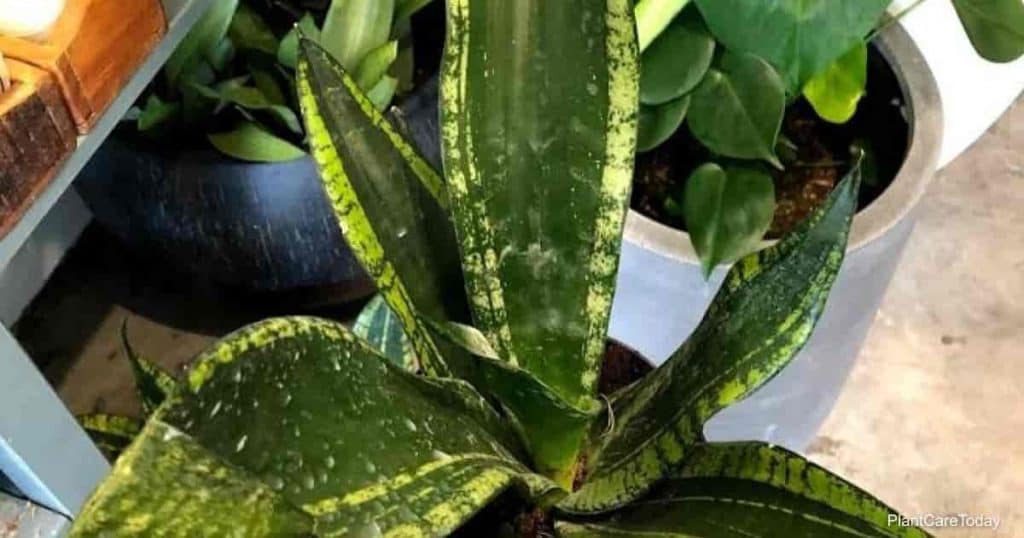Commonly referred to as snake plants, sansevierias are popular types of succulent plants known for their attractive spiky to ovate leaves.
These indoor plants are relatively easy to care for and make a great statement both indoors and outdoors.

Some of the more popular varieties include:
- Bantel’s Sensation
- Black Gold
- Boncel Snake Plant
- Sansevieria ‘Golden Hahnii’
- Shark Fin Sansevieria
- Starfish Sansevieria
One of the great things about these plants is the sheer number of variations on a theme, resulting in a Sansevieria for every taste.
Unfortunately, snake plants aren’t immune from infections and infestations.
Powdery mildew, root rot, and sooty mold are common problems with these plants.
Aphids, mealybugs, spider mites, and vole weevils are also known to attack the plant.
Related: Aphids on Succulents
Neem oil is one of the most trusted natural remedies, but can it be safely used on these wonderful succulents?
Will Neem Oil Harm Snake Plants?
When used properly, Neem oil insecticide won’t harm your snake plant.

However, care must be taken when using this potent home remedy.
The Risks of Undiluted Neem Oil
Neem oil contains several active ingredients, at least five known to have insecticidal properties.
The most important of these is Azadirachtin, a powerful chemical compound that mimics the hormones of many insects.
Unfortunately, undiluted neem oil is very potent and may cause chemical burns or even kill your plants.
Clarified hydrophobic neem oil has most of the Azadirachtin removed, with only .5 to 3% percent remaining.
This version of Neem is gentle enough to use topically when properly diluted.
However, raw neem oil can still cause burns even when diluted, making it best for use as a Neem soil soak.
A third version of Neem, neem cakes, are the solids left from extracting neem oil and are a useful fertilizer with additional anti-pest qualities.
Neem cakes can cause the same types of burn as other fertilizers and should never be applied directly to the plant or exposed roots.
The Benefits of Neem Oil
When used properly, neem oil provides many great benefits for your plant.
A neem foliar spray made of clarified hydrophobic neem oil is a topical insecticide that will suffocate most pests it comes in contact with.
It can also reduce or kill many topical fungal infections, such as sooty mold and powdery mildew.

Many people like to use this form of treatment as a leaf shine.
100% percent cold-pressed raw neem oil is applied as a soil soak and becomes a systemic insecticide once absorbed by the plant.
Insects and arachnids that consume Neem through the plant’s sap will lose their appetite, starving to death.
Additionally, it can prevent nymphs from reaching the next growth stage, render adults infertile, and cause a colony to die out completely.
It will also protect the plant from invasive bacterial, fungal, and microbial infections for up to 22 days after application.
It’ll kill grubs, nematodes, and other soil-base4d pests without harming earthworms and other beneficial critters.
Finally, Neem cakes have a general NPK of 4-1-2 and contain trace amounts of neem oil.
They not only feed your plants but help fight off fungi, nematodes, grubs, and even root rot.
How to Properly Use Neem Oil on Sansevieria
As mentioned, Neem must be properly diluted before using it safely.
Thankfully, the recipes are very simple and require only three ingredients.
- Begin by emulsifying some water so the oil will mix in.
- You can use ⅓ to 1 teaspoon of Dawn dish detergent, insecticidal soap, pure castile soap per quart of distilled water, or one teaspoon per gallon.
- While this step may be skipped for plants sensitive to soaps, it allows for a safer, more even application of Neem.
- Next, add 1 teaspoon of clarified neem oil (preferably 1% percent, unless you have an extensive infestation) per quart to make a foliar spray or 2 tablespoons of raw Neem per gallon for a soil soak.
- 24 hours before use, test a small portion of the plant with your neem solution to ensure the plant isn’t oversensitive or has a neem allergy.
- Apply the foliar spray by spraying down every surface of the entire plant thoroughly, making sure to do so at either dusk or dawn when spraying outdoor plants.
- The neem oil will dissipate in approximately 45 minutes to 1 hour.
- Apply every other day for 14 days or until the infestation is gone.
- The spray may also be applied every 14 days as a preventative or leaf shine.
- For the soil soak, pour 2 to 4 cups of the soak onto the soil around your plant, being careful not to splash the plant itself or get any on exposed roots.
- The soak will remain effective for up to 22 days, so you will only need to reapply once every three weeks, whether using it as a treatment or preventative.
Neem cakes are even easier to use, as they are applied when it’s time to feed your plant.
Take note of your snake plants fertilizer needs and dilute the cake as instructed on the package.
For plants that require a balanced NPK, amend the cakes with a fertilizer that will balance out the NPK ratio, being careful to dilute the mix further as needed to avoid over-fertilizing.
